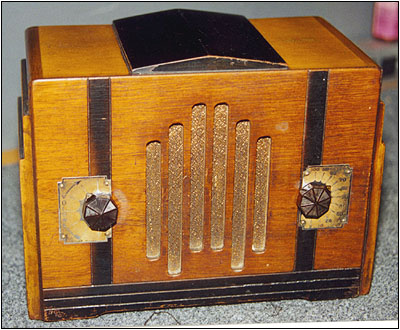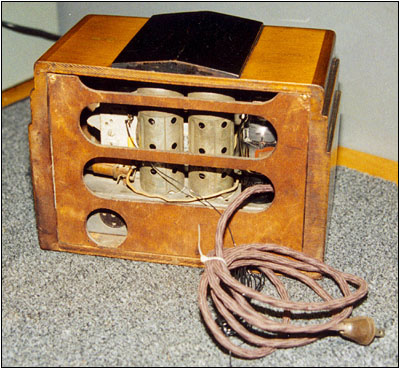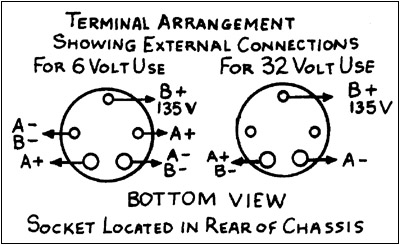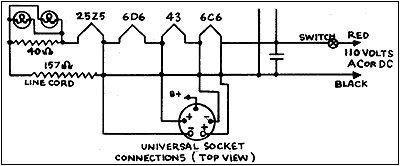Of Old Radios And Related Items--Published Monthly
Eureka! It's a Clarion TC30
Or is it?BY RAY BINTLIFF
WEB EDITION
In this article, Ray Bintliff describes his efforts to identify a radio -- a sort of radio genealogical search in which he discovers some interesting similarities to other 1930s sets. (Editor)
At first glance, the 4-tube 1930s AC/DC TRF radio shown in Figure 1 looks much like other "midget" radios produced during the mid-1930s. The cabinet style is similar to those used by a number of manufacturers and the layout is conventional -- with two controls on each side of the center-mounted speaker. The tube complement consists of the following types: a 6D6 RF amplifier, a 6C6 detector, a 43 audio output, and a 12Z3 half-wave rectifier. Some similar sets used a Type 25Z5 tube as the rectifier. This radio and most others used a resistance line cord to drop the AC line voltage to the appropriate filament voltage. Some radios of this ilk used a ballast tube instead of the resistance line cord.
OK then, what makes this radio different? As Figure 2 shows, there is a 5-pin tube socket located on the rear apron of the chassis. But for what purpose? A schematic diagram is glued to the bottom of the cabinet that declares the radio to be a Model 45 but there are no clues to the radio's maker or brand name. Further, the schematic diagram does not include the mysterious 5-pin tube socket which probably serves as an adapter socket.
Manufacturer Search
My search of some collector's guidebooks produced some interesting results. Based upon appearance alone, a host of possible manufacturers were found. To narrow the search, I eliminated the major manufacturers on the assumption that a large company would have identified its radio in some fashion. There is no evidence that a decal, label or logo has been removed from the radio or cabinet. This decision reduced the list of possible brands to Auburn, Berkshire, Clarion, Climax, Colonial, Halson, Kadette, LeWol, Monarch, Pickwick and Premier.
Next, I searched some Rider volumes for radios that used the same tube complement and came up with the following sets: Arvin 403, Clarion TC30, Climax 4-tube AC/DC, Detrola 403, DeWald 430, Federated Purchaser 53 and Howard A12. The schematic diagrams for these radios do not show a 5-pin socket, but then neither did the schematic for my radio. So, I compared my radio's schematic to those in the Rider volumes and found a match with the Clarion TC30.
Figure 1. This small 4-tube AC/DC TRF radio of the mid-1930s lacks a manufacturer's name.
Figure 2. A rear view of the radio shows the adapter socket at the lower left.
The Clarion schematic can be found in Rider Volume V under Transformer Corporation of America (TCA), page TCA 5-6. The schematic on the bottom of the cabinet differs from the Rider page only in that it does not carry the name or address of TCA and the model numbers are different. Thus, it seemed safe to conclude that the radio in question was manufactured by TCA.
Technical Search
Once the manufacturer was identified, I returned to the Rider volumes to discover the purpose of that adapter socket. This time I looked for schematics that included an adapter socket and used the same or similar tube complement. The following radios were found: Allied F-9525, Autocrat 4LW, Howard AA-25, LeWol LW4, Radolek 10931 and 11910, Trav-Ler 50A and Warwick 419 and 420.
After I took a quick look at the schematics, the answer became clear -- the adapter socket is used to operate the radio on voltages other than 110 volts. These radios are described below.
The Allied Model F-9525 uses a Type 25Z5 as a half-wave rectifier. The radio came with an adapter cord, a resistance line cord and a 6-pin plug that allowed operation on 110 volts DC or AC. According to Rider, other adapters were available "from the factory at a slight extra cost for operating this receiver on automobiles, 32-volt farm light plants, and 200- (sic) volt AC or DC." The Rider page also notes that "Cord for 110 volts or 220 volts heats moderately, as the cord contains resistance necessary for operation at these voltages."
This radio offers the most options for operation on power sources other than 115 volts. Its tube complement, consisting of Types 39/44 RF, 77 Detector, 43 Audio output and 25Z5 half-wave rectifier, bears little resemblance to the Clarion. But despite the difference in tube complement, the Allied radio's adapter socket is a useful clue regarding the purpose of the Clarion's socket.
The Autocrat Model 4LW uses a 7-contact adapter socket. The schematic diagram notes that 6-volt or 32-volt operation is possible but does not provide hook-up instructions. This radio is a bit different in that the 25Z5 is used as a voltage doubler.
Figure 3. This adapter plug and socket hookup for the Howard Model AA-25 is typical of those found in my search.
Figure 4. A partial schematic diagram of the Warwick models shows the filament to socket connections.
The Howard Model AA-25 uses a Type 25Z5 as a half-wave rectifier and includes a 5-contact adapter socket. Figure 3 depicts the adapter arrangement for 6- and 32-volt operation. The radio's schematic diagram carries the notation "In all cases of 6- and 32-volt operation, replace the 43 tube with a 41 tube." While not specifically stated on the schematic, it is apparent that the choice of 6- or 32-volt operation applies to filament voltages only and that a separate B supply is also required. When the radio is operated on 6 or 32 volts, the filament of the 25Z5 is out of the circuit.
The LeWol Model LW4 also uses a 25Z5 as a half-wave rectifier, but the adapter socket accepts a 5-pin plug. The schematic diagram identifies the adapter socket as an "Auto socket" (as in automobile) and implies 6-volt operation only. Although unstated, it is obvious that the Type 43 tube would need to be replaced with a Type 41 to operate the radio's filament on 6 volts.
The Radolek Models 11910 and 10931, like the Howard, employ a 25Z5 as a half-wave rectifier and a 6-contact adapter socket. Hook-up information is not provided.
The schematic for the Trav-Ler Model 50 is identical to the Radolek schematic. This fact raises the question -- did Radolek manufacture radios for Trav-Ler or vice versa?
The same question springs to mind after looking at the schematic for the Warwick Models 419 and 420. The adapter socket information is identical for the Howard and the Warwick models. And the schematics are identical, except that the Warwick models have a band switch for the broadcast and shortwave bands. A partial schematic for the Warwick models is shown in Figure 4. It depicts the connections between the adapter socket and the tube filaments.
Use of adapter sockets seems to have ended with the 1936 models. Perhaps the feature was not very popular and manufacturers were interested in keeping the costs down on these low-end radios. (Ray Bintliff, 2 Powder Horn Ln., Acton, MA 01720)
Ray Bintliff, a frequent contributor to A.R.C., holds an Amateur Extra Class license. A retired engineer, he enjoys repairing and restoring pre-1945 radios and test equipment. In addition to Amateur Radio, his interests include electronic equipment design and audio reproduction.
| [Free Sample] [Books, etc., For Sale] [Subscribe to A.R.C./Renew] [Classified Ads] [Auction Prices] [Event Calendar] [Links] [Home] [Issue Archives] [Book Reviews] [Subscription Information] [A.R.C. FAQ] URL = http://www.antiqueradio.com/Clarion_TC30_04-00.html Copyright © 1996-2000 by John V. Terrey - For personal use only. Last revised: April 1, 2000. For Customer Assistance please contact ARC@antiqueradio.com or call (978) 371-0512 Pages designed/maintained by Wayward Fluffy Publications
Antique Radio Classified |



